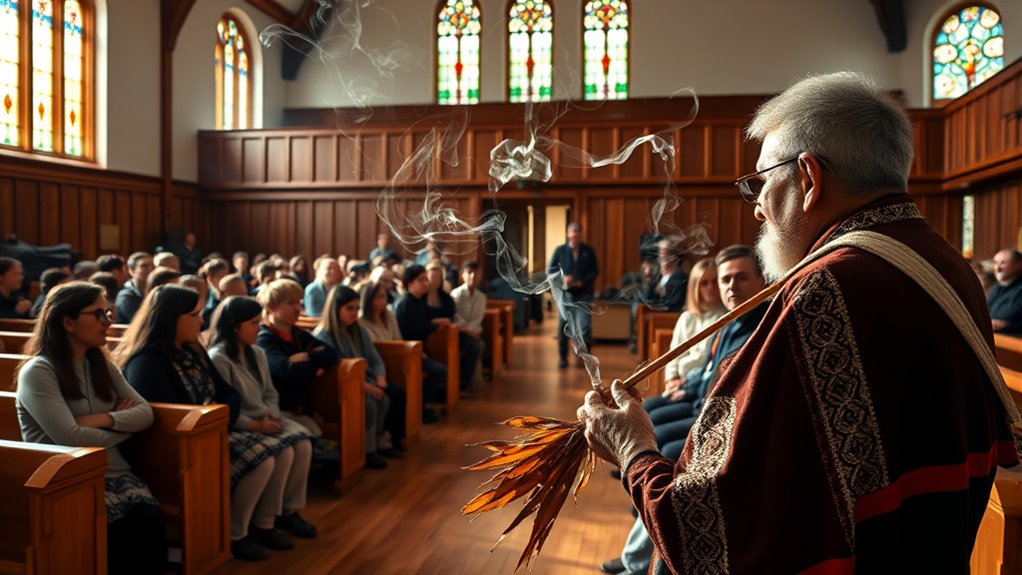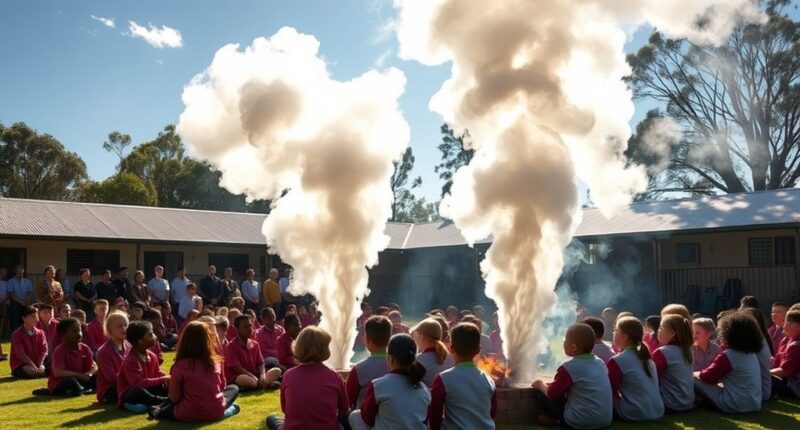Starting a school assembly with a smoking ceremony shows respect for Indigenous traditions and promotes inclusivity. It honors the land’s original custodians, connects everyone to cultural heritage, and fosters understanding and empathy. This meaningful practice sets a positive tone, encourages unity, and celebrates diversity within your school community. By including such ceremonies, you create a respectful environment that values history and shared values. Keep exploring to discover ways to truly embrace this powerful tradition.
Key Takeaways
- Honors land custodians and Indigenous communities, fostering respect and acknowledgment of cultural heritage.
- Promotes inclusivity, mindfulness, and unity among students and staff at the start of assemblies.
- Reinforces cultural awareness and understanding of traditional practices and their significance.
- Strengthens community bonds by connecting attendees to shared history, spirituality, and collective identity.
- Sets a respectful, meaningful tone that encourages appreciation of diversity and cultural reconciliation.

School assemblies often serve as powerful platforms for cultural traditions and community values, including smoking ceremonies. When you begin an assembly with such a practice, you’re honoring the cultural significance of these rituals, which have been passed down through generations. These ceremonies are more than just symbolic gestures; they carry deep meaning, connecting communities to their history, spirituality, and collective identity. Incorporating a smoking ceremony into your assembly demonstrates respect for indigenous cultures and highlights the importance of preserving traditional ceremonial practices. It’s an opportunity to educate attendees about the rich history behind these rituals and how they serve as a form of welcome, protection, and healing.
By starting with a smoking ceremony, you set a tone of respect and inclusivity. The ceremonial practice involves burning sacred plants like eucalyptus or tea tree, creating smoke believed to cleanse and purify the space. As you observe or participate in this process, you acknowledge the spiritual significance behind it—an act that fosters a sense of unity and mindfulness among students and staff. It’s a gesture that recognizes the land’s original custodians and demonstrates cultural awareness, which is crucial in today’s diverse educational environment. This act of acknowledgment can cultivate empathy, understanding, and appreciation for different cultural backgrounds, making your school community more welcoming and respectful.
Starting with a smoking ceremony honors land custodians and promotes unity, mindfulness, and cultural respect among students and staff.
Incorporating ceremonial practices like smoking ceremonies into school assemblies isn’t just about tradition; it’s about fostering a deeper connection to cultural heritage. When you make this a regular part of your assembly routine, you’re reinforcing the importance of respecting cultural practices and understanding their significance. It encourages students to learn about the histories and customs of the Indigenous peoples, promoting cultural literacy and sensitivity. Additionally, it provides a meaningful way to start the day, grounding everyone in shared values of respect, reconciliation, and community. Such practices can inspire students to carry these principles beyond school walls and into their everyday lives, promoting a more inclusive society. Understanding the cultural significance of these rituals enriches the experience and fosters genuine respect.
Ultimately, beginning an assembly with a smoking ceremony is a powerful reminder that culture shapes our identities and values. It’s a ceremonial practice that embodies respect, tradition, and community spirit—all essential qualities for fostering a positive, cohesive school environment. When you incorporate this into your routines, you’re not just observing a tradition—you’re actively participating in a meaningful act of cultural recognition and unity. This simple yet profound gesture can transform the way your school community perceives diversity and shared history, making every assembly a respectful celebration of cultural heritage.
Frequently Asked Questions
What Is the Historical Origin of Smoking Ceremonies?
You’re curious about the historical origin of smoking ceremonies. These Indigenous rituals date back thousands of years and hold deep cultural significance. They are traditional practices used to cleanse, protect, and connect with spiritual domains. By understanding their origins, you appreciate their importance in Indigenous cultures. Incorporating smoking ceremonies in school assemblies honors these traditions, fostering respect and cultural awareness among students.
Are Smoking Ceremonies Culturally Sensitive or Appropriate for All Schools?
You might wonder if smoking ceremonies are culturally sensitive or appropriate for all schools. It’s important to take into account cultural sensitivity and appropriateness considerations, as these ceremonies are deeply rooted in specific Indigenous traditions. While they can promote respect and understanding, you should ensure they’re conducted with proper permission and context. Respecting cultural significance and avoiding cultural insensitivity ensures that these ceremonies are meaningful and appropriate for your school community.
How Long Does a Typical Smoking Ceremony Last?
A typical smoking ceremony usually lasts around 10 to 20 minutes, depending on its purpose and cultural context. When planning, you should consider timing considerations to guarantee it fits smoothly into your schedule. The ceremony duration allows for respectful observance and meaningful participation. You’ll want to allocate enough time for the ritual itself and any reflections or speeches that follow, creating a thoughtful, respectful experience for everyone involved.
Can Smoking Ceremonies Be Adapted for Different Age Groups?
You can definitely adapt smoking ceremonies for different age groups by tailoring the content and delivery. For younger students, simplify explanations and focus on educational integration, emphasizing respect and cultural awareness. For older students, include more detailed history and significance. This way, you guarantee the ceremony remains meaningful and age-appropriate, fostering understanding and appreciation of the cultural practice across diverse age groups.
What Training Is Required to Perform a Smoking Ceremony?
You’d think performing a smoking ceremony requires a magic wand, but it’s all about understanding its cultural significance and proper ceremony preparation. You need dedicated training in Indigenous traditions, respectful protocols, and safety measures. This guarantees you honor the ceremony’s deep meaning while safeguarding everyone involved. By gaining this knowledge, you deliver an authentic, respectful experience that connects students to history and culture in a meaningful way.
Conclusion
Imagine stepping into a school assembly and feeling a thread of connection weaving everyone together, like smoke rising and drifting in harmony. Just as a smoking ceremony honors tradition and fosters unity, starting assemblies this way can deepen respect and understanding among students. It’s a simple act that transforms a routine gathering into a powerful moment of cultural acknowledgment. Embracing this practice isn’t just about ceremony; it’s about cultivating a more inclusive, mindful school community.
Mary is a passionate writer who brings creativity and a fresh perspective to our team. Her words have the power to captivate and inspire, making her an essential contributor to our content. Mary’s commitment to storytelling and dedication to promoting Indigenous culture ensures that her work touches the hearts of our readers. We’re fortunate to have her as part of our team.









